

How Coffee is Processed
Coffee is the second-most-valuable commodity in the world, second only to oil. Worldwide, people consume approximately 2 billion cups of coffee daily.
The retail value of the U.S. coffee market was $48 billion in 2015, according to the Specialty Coffee Assoc. of America. The average American spends $21 a week on coffee, and average coffee drinkers drink three cups of coffee a day. Ready-to drink, iced, and cold brew coffee consumption is rising. Nitro coffee, coffee that is poured from a tap and has a mouthfeel similar to beer, is also rising in popularity. The single-cup category and foodservice coffee sales are also growing.
Nutritionally, coffee is a good source of antioxidants—Americans get more antioxidants from coffee than from any other beverage. Additionally, coffee contains nutrients like riboflavin, pantothenic acid, manganese, potassium, magnesium, and niacin. Last, but not least, it contains caffeine. Studies have shown that coffee may lower the risk of type 2 diabetes, Alzheimer’s disease, Parkinson’s disease, and dementia.
Want to know more about this magical beverage? Take a look at the steps behind the making of your favorite cup of joe:
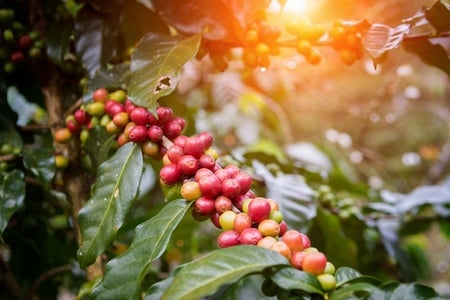
Step 1: Bean Growth
Coffee plants flower three to four years after planting. Coffee cherries develop from the flowers. The cherries ripen about eight months after flowering and change color from green to red.
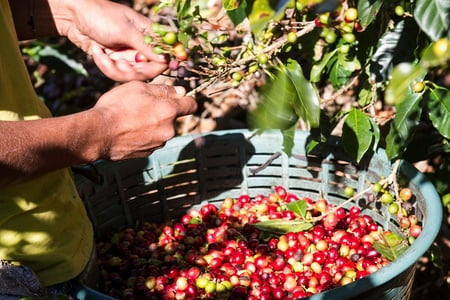
Step 2: Harvesting
Coffee fruit is removed from the trees using one of two processes: strip picking or selective picking. In strip picking, all of the coffee fruit is removed from the tree regardless of maturation. In selective picking, the ripe, red cherries are harvested, and this is generally done by hand. This process is more labor intensive than the strip picking and is generally used for finer arabica beans.
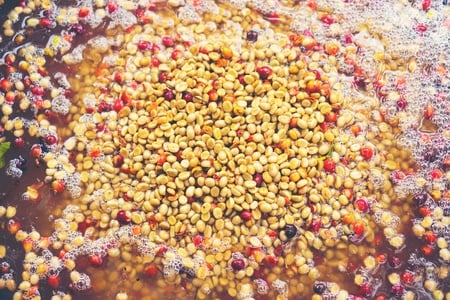
Step 3: Separation
Whatever the harvesting method, green and overripe coffee cherries inevitably end up mixed together with perfectly ripe coffee cherries. There are two main methods of separation: wet and dry. In the wet method, overripe and underdeveloped coffee cherries, sticks, and leaves float in water, while ripe coffee beans and green coffee cherries sink. The first step in wet coffee processing is separation of "floaters" from "sinkers." In dry processing, harvested cherries are separated by winnowing, which is commonly done by hand with a large sieve but can also be done mechanically.
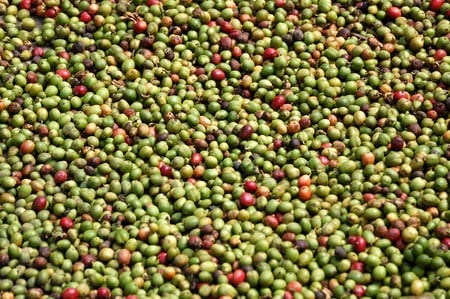
Step 4: Processing and Drying the Cherries
There are three main methods used to process and dry coffee cherries: the dry process, the wet process, and the semidry process.
In the dry process, freshly picked cherries are spread out on the ground or on raised tables to dry in the sun. They are raked and turned throughout the day and covered at night to keep them from getting wet. When done properly, dry-processed coffee results in a smooth and heavy-bodied brew.
In the wet process, the freshly harvested cherries are passed through a pulping machine to separate the skin and pulp from the bean. The pulp and the beans are then separated by centrifugal force and a barrel screen system. After the pulp has been removed, the beans with their parchment skin are dried in the sun and/or in a hot air dryer. The wet process results in a clean, balanced flavor and a fruity acidity.
The semidry process is a hybrid process. In this relatively new process, the outer skin of the cherries is removed mechanically by wet grinding, using pulping machines, and the wet beans covered in mucilage are stored for one day. The mucilage is then washed off and the coffee beans are dried. The semidry process produces coffees that are heavy-bodied, earthy, and mildly acidic.
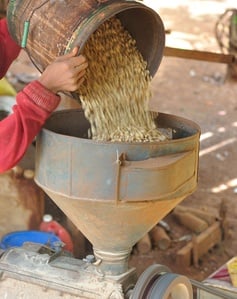
Step 5: Hulling and Polishing
Hullers are used to remove what is left of the fruit on the bean, whether it is the crumbly parchment skin of wet-processed coffee or the parchment skin and dried mucilage of semidry-processed coffee or the entire leather fruit in dry-processed coffee. Polishing is an optional method that removes any remaining silver skin from the beans following hulling. It is done to improve the appearance of the green beans. Care must be taken because the temperatures experienced by the beans during polishing may be detrimental to final coffee flavor.
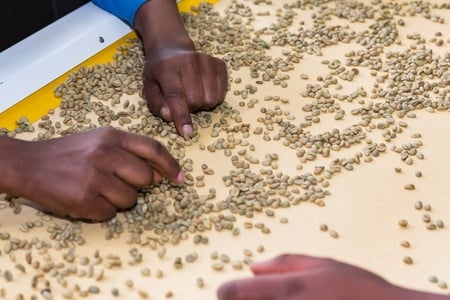
Step 6: Cleaning, Sorting, and Grading
Fine coffee is sorted and cleaned through a multistep process. Air sorters, sieve shakers, and gravity separators are used to separate based on density and size. Color sorting is performed using machines or by hand. Final grading is based on size, growing location and altitude, harvesting, taste, and cup quality.
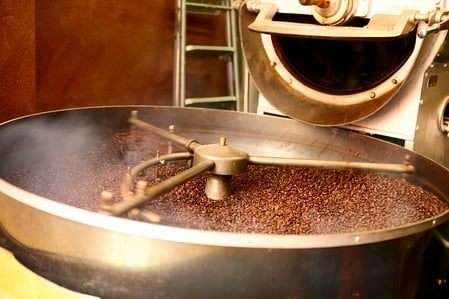
Step 7: Roasting
Beans are commonly roasted in large commercial roasters, placing beans in large metal cylinders and blowing hot air on them. The older method roasted over an electric, gas, or charcoal heater. Roasting gradually raises the temperature of the beans to between 180°C and 230°C. This triggers the release of steam, causing the beans to swell as well as darken in color and develop roasted flavors.
Step 8: Brew and Enjoy!
Finally, the step you've been waiting for all morning...

